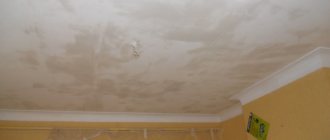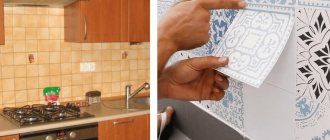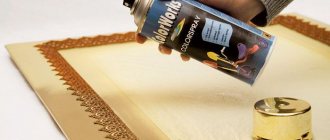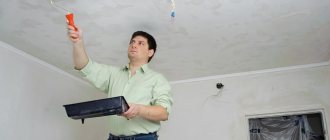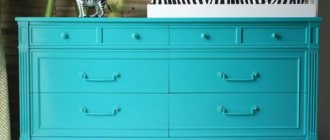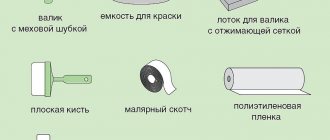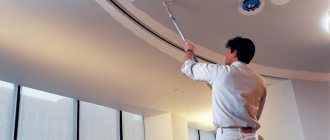Home / Painted and bleached / Types of ceilings / Restoring a whitewashed ceiling
Sometimes, when carrying out repair work, the old ceiling covering still looks quite tolerable, but there is a desire to give it a little more “marketable appearance”. Let's talk further about how to refresh a whitewashed ceiling. This can be done, although it will require a whole range of measures.
In general, painting the ceiling after whitewashing is only possible with the same composition that was applied earlier. If chalk was used, then such a coating can be restored by simply washing off the old one and repainting, but if plaster and lime are applied, then there will be much more work.
Is it possible to paint directly over old whitewash?
Certain situations provide for such a solution. Before you paint a whitewashed ceiling, you need to make sure that the old whitewash is still holding strong enough and does not lag behind the floor slab anywhere. If there are no cracks or lagging areas, then this coating can be repainted.
In principle, this solution is suitable for all types of painted surfaces, but you should take into account what everything was painted with before. If chalk was used, then you should not use lime - you will only get unsightly stains. The same applies to the reverse option - you should not whitewash with chalk compounds based on lime.
In general, it is better to avoid re-application over the old coating. Even the most durable, it loses its adhesive properties over time and can simply crumble.
This is especially true when painting not with chalk or lime, but when using ready-made store-bought compositions. It's better to work a little and get a decent result in the end than to curse yourself for laziness when you see the new coating peeling off.
When choosing what to paint the ceiling after the previous whitewashing, it is better to opt for water-based paint if the old one has not been completely cleaned off. Since this type of coloring composition goes better with a whitewashed base.
Revealing the essence of the problem
This unpleasant situation occurred due to the fact that the new coating was applied to the whitewash without any preliminary surface preparation. And, whatever one may say, it is necessary to prepare it, and very thoroughly. Lime is a finishing material, the most popular in the union. And it has achieved such popularity due to the fact that it does not wash, is not afraid of getting wet, is not washed off with water, is durable, has antifungal properties, repels insects and works great in damp, even basement areas.
The properties, as you can see, are impressive, but lime is applied to the surface only with a very thick composition. And this causes an uneven surface, which, among other things, is also heterogeneous; blurs and, in some places, smudges are visible. Therefore, it is not used in modern finishing works.
Also, working with lime is complicated by the fact that when applied, this material penetrates deeply into the surface and after a long time begins to peel off, not in an even layer, but in flakes. This makes its removal so difficult that cleaning the ceilings from lime when hiring workers costs a lot of money, and the apartment is then very dirty.
If you decide to apply a layer of any paint to a ceiling finished with this solution, the end result will be sad in any case. Even after you pass the roller once, about a dozen flakes with a diameter of 5–7 mm will remain on it, and they will create indentations on the ceiling.
If you try to paint them over, the process will repeat again. In general, the more attempts you make to remove these flakes from the roller and begin to paint over the imperfections, the greater the avalanche of events you will cause, because the lime will become soaked and flake off even more.
This option, that is, without pre-treatment, is suitable only in a few cases. The first is if you treat such a ceiling with lime again. It will become white and, at first glance, beautiful, but it will be uneven, and when light hits it, it will be completely scary. This method is only suitable for country rooms, technical premises or industrial facilities, where the aesthetic side of the issue is not important.
Well, the second option is to be content with what you get. If the lime coating is no more than 5 years old and it was installed properly, then if you correctly apply paint over the old whitewash you will get a more or less acceptable result. That is, the flakes will be visible, but not so much as to be obvious. Of course, this method is not suitable if you are undertaking a full-scale renovation, but it is quite suitable for updating the coating.
Finally, I will say that you may still be lucky. The ceiling in some rooms was painted not with lime, but with chalk mortar. It is easily removed from the surface with a spatula, and the residue is easily washed off with water. But such cases are rare. It is very easy to distinguish chalk from lime - just run your hand over the surface. If the palm is completely white, then it is chalk. If there is nothing left on it, or literally a mess, then it is lime.
As I understand, you have already drawn conclusions from what you read above, let’s continue further.
Determining what has been done
This is easy to do - you just need to run your finger along the plane and look at it. If the finger turned white, then chalk was used, as it gets very dirty. In this case, you can get away with a small list of work.
If the coating does not stain your hand, then, most likely, lime has been applied, which will not tolerate simple repainting. It can easily crumble. Therefore, it must be completely removed from the plane.
In cases where a water-based emulsion is applied to the surface, you will also first have to remove the building coating where it has begun to lag behind the surface. This can be done using a spatula and various special compounds.
Acrylic paints
The most popular and popular are acrylic-based paints. As the name suggests, it contains acrylic resins, which provide affordable pricing and high quality. And the admixture of latex elements gives the product the necessary elasticity. Thanks to this, you can close and disguise small cracks on the work surface. The parameters of cracks, which can easily disappear under a layer of water-based emulsion, should be within 1 mm. If the composition contains latex impurities, then the price for this type of paint will be slightly more expensive. But, at the same time, painting an imperfect surface will be much easier, and the result will please you.
Removing the layer of old coating
The easiest way is to paint the ceiling after whitewashing with chalk. Since it is quite simple to remove the chalky coating - it is soaked and partially washed off with ordinary warm water. After this, the entire layer is easily removed with a regular spatula.
Next, you can prime and paint, but in situations where paint or lime is applied to the surface, it will be more difficult to remove the old layer.
For lime coatings, you will need a spatula, which will need to be used to remove all loose areas of the coating. This work is quite tedious, but even small lagging areas cannot be skipped - then, when a new layer of coloring composition is applied, it can easily “wrap around” the roller in this place, being soaked with primer and new paint.
The paint may remain on the surface, but first you also need to roll it with a wet roller and see if it comes off the ceiling. If such areas are found, you need to clean them with a spatula, right down to the concrete slab.
When the old layer is completely removed, you can begin further work to give the ceiling a beautiful look.
How to paint a whitewashed ceiling
Before starting repair work, make sure you have the following tools:
- Remedies;
- brushes of various sizes;
- roller;
- masking tape;
- grinding material;
- putty knife;
- paint tray.
The process of preparing the surface for painting begins with cleaning the old layer of lime using the washing method. The whitewash layer is abundantly moistened with water. The soaked base is removed with a spatula. Then the cleaned surface is washed with a painting sponge and the remains of the old layer are removed.
Areas with stains of grease, rust or traces of bleaching are treated with copper sulfate or a solution of hydrochloric acid diluted with water in a ratio of 1:3.
If there are gaps, depressions, or cracks in the ceiling, they are sealed with plaster or putty.
For good adhesion of finishing materials, thin-layer putty with high adhesion rates is applied to the cleaned and dried area. After 2-3 hours, everything is sanded with fine-grained sandpaper.
A primer is necessary for more even painting. To do this, roll the composition over the surface with a roller or brush and leave to dry for at least 2 hours.
Primer work
Here you should pay attention to the seams and joints of the ceiling tiles. They must first be thoroughly cleaned of all old putty and paint. After this, all such places are primed with a brush, not a roller.
The main plane also needs priming. When performing this stage of work, areas with a lagging old layer of paint or whitewash that were not noticed before may appear on the surface. They should be thoroughly cleaned down to concrete and primed again.
Oil paints and enamels for ceilings
In addition to water-based paints, oil paints and alkyd enamels are used to finish the ceiling . The former use organic oils or drying oil as a binder, the latter use alkyd varnishes and organic solvents. And both of these types of paints have recently been increasingly losing their popularity. Let's figure out why this happens.
Oil paints
Alkyd enamels make it possible to obtain a fairly strong and durable coating on the ceiling, but at the same time they are difficult to work with - they take a long time to dry and emit unpleasant and even harmful odors to humans. In addition, such enamels have low vapor permeability, which does not have the best effect on the quality of such a coating on the ceiling, especially if it is a kitchen or bathroom ceiling.
Oil paints are even worse in their durability and properties. In addition to long drying times, unpleasant odor and low vapor permeability, a layer of oil paint is very fragile and can crack even from mild mechanical stress or simply over time. The only advantage of these materials is their very low price, so they should only be used if you have a very limited budget for finishing the ceiling. But think about it, is it worth saving on material in order to repaint everything again in a few years?
Whitewash
Then everything will depend on the quality of the prepared composition for whitewashing or on how good the paint will be used.
The first direction of movement of the coloring layer should go across the light flow entering the room. Simply put, along the wall on which the window is located.
The next direction of coloring is across the first. If there are more than two passes for painting, then it is necessary to select their directions so that the last one is directed away from the window.
To paint with different compositions, you need to use different tools. It is best and easiest to use a spray gun, but not everyone has such a device. Therefore, most people prefer a roller.
You should always start painting from the corners and lines along the walls. To do this, use a narrow brush. It is more convenient for her to work in the corners, and along the wall, a strip of paint is applied so as not to stain the walls with a roller. In addition, the roller will leave unpainted stripes where its edge simply does not fit close to the wall.
You should take a roller with medium pile. A small pile can leave unpainted areas, but too long pile paints everything quite thickly. And besides, it’s harder to work with such a roller.
If in some areas the whitewash begins to peel off, it means that the work on cleaning the surface was done poorly, and after the applied coloring composition has dried, in such places you should clean the surface down to the concrete and putty it again.
Preparing to paint the ceiling
Before starting paint application, a number of preparatory work should be carried out. This will help you avoid additional complications and wasting time. First, a thorough inspection of the surface is carried out using special lighting “at an angle.” Using this method, you will be able to notice all the flaws and better assess the condition of the surface being examined.
If there are strong defects, additional work must be done to level the surface. Rough bumps, potholes and cracks cannot be corrected using paint materials alone. You will have to allocate additional time to eliminate such flaws. In this case, additional costs will arise for the purchase of leveling materials and appropriate tools. Old paint must also be removed. Only after the process of leveling the ceiling and drying it has been completed will it be possible to proceed to the next stage.
Water-emulsion and water-dispersion
However, water-based and water-dispersion paints are simply ideal for painting ceilings. But here again we have a choice... Which is better, water-based or water-dispersed. What are their main differences?
Simply put, if you want to paint your ceiling with water-based paint, then you simply won’t be able to wash it afterwards, since the paint will be washed off consistently. Ceilings painted with water-dispersion paint can be washed repeatedly.
Water-dispersed also has its own division: latex, which has an acrylate base, and acrylic with the addition of latex. Often these paints contain various antifungal additives.
How to achieve better results?
Observing the following rules helps to obtain a durable, even coating:
- Each layer of coating is thoroughly dried. The painted areas are left for at least 4 hours. During work, the surface is inspected, identifying gaps and defects.
- In the first weeks after painting, the coating is protected from ultraviolet radiation. You should also avoid the appearance of cold air currents in the room. Drafts do not speed up drying, but destroy the structure of the coloring composition.
- Apply the finishing material, applying equal pressure to the roller. Dents and sagging cannot be removed by applying a new coat of paint. The coating is removed and the surface is puttied again. If defects in the form of stripes are detected, the coloring agent is mixed and reapplied.
The quality of the coating depends on the type of compounds used. When choosing products, study the information provided by the manufacturer. It is recommended to use ceiling emulsions that are resistant to wear.
What is the best paint for the ceiling: choose according to the criteria which paint is best to paint the ceiling
The entire look of the room depends on how neat the ceiling looks. A smooth, light surface can add light to a room. If the ceiling is painted with high quality, it is sometimes even specially used to enhance illumination by pointing lamps at it. And vice versa, even seemingly insignificant defects - unevenness of the coating, stripes or changes in tone - can blur the overall impression of the interior, regardless of how neat and “rich” the finishing of the walls and floors is.
What is the best ceiling paint?
Therefore, for the owners of an apartment or house who are about to begin renovation, the question inevitably arises - which ceiling paint is better in terms of quality, composition, and performance characteristics?
The construction market offers a wide range of different paints produced by domestic and foreign manufacturers. In order not to make a mistake with your choice and to purchase really high-quality material that will have a long service life and will be comfortable to work with, you need to consider different options.
Paint selection criteria
First of all, you need to decide on the criteria by which you need to evaluate the paint in order to know what to pay special attention to when choosing:
- Repairs are not done for one year, so one of the key requirements is the service life of the purchased material.
- The plasticity of the paint solution - this quality will help to avoid cracks when the painted surface dries and when it deforms, for example, when the house shrinks.
- The ability to carry out regular wet or dry cleaning of the surface, which means the paint should create a durable paint that is little susceptible to abrasion loads.
- High-quality paint should ensure easy and even application of the composition to the ceiling, while hiding minor surface defects as much as possible.
- An important selection criterion is affordability. True, there are no clear-cut solutions to this issue - often the paint compositions of leading manufacturers cost a lot, but this is fully justified by the highest quality of the products.
What compositions are optimal for the ceiling?
As the practice of finishing work shows, most often “good old” whitewash and water-based paint compositions are used for ceiling surfaces in residential premises.
Whitewash has been used since time immemorial. Its widespread use in past years was explained by the fact that at first a better option was simply not invented, and then high-quality paint was extremely difficult to find in stores. The craftsmen tried to improve the paint composition by conducting experiments and adding various natural adhesives to it, achieving greater adhesion and durability of the material. Some finishers have not abandoned chalk painting to this day, considering it the most environmentally friendly solution.
Many owners still prefer conventional whitewashing
A water-based composition is an emulsion, which is a solvent - ordinary water, in which tiny drops of a polymer film-forming substance, insoluble in it, are suspended. After applying paint to the surface, the water evaporates and the particles join together, creating a thin polymer film.
So, according to experts, only four types of water-based paint are suitable for the ceiling, which differ in their composition - chalk, acrylic, latex and acrylate.
- Ceiling paint made from water and chalk is otherwise called whitewash. This composition can be called an economy option, since it has the lowest price. But you need to understand that this finish has significant disadvantages:
— The material is capable of absorbing various fumes, which can leave unsightly marks on the surface and permeate the ceiling with a not always pleasant smell;
— Such a ceiling cannot be washed, since water, along with dirt, will wash off the paint itself. Therefore, if stains appear on the surface of the ceiling, it will have to be washed well and painted again;
— Chalk paint is not resistant to abrasive influences—if you run your hand over such a surface, marks will remain on it;
— Chalk-based paint can deteriorate especially quickly on the kitchen ceiling, so it is highly undesirable to use it there.
- Acrylic paint consists of ingredients such as chalk, acrylic polymer and water. This option is more resistant to external factors, but is also not durable enough. The composition can be used for painting ceilings in residential areas with normal humidity and in the absence of foreign odors and fumes - this could be a living room, a children's room or a bedroom.
Acrylic paint for ceilings
A ceiling coated with this composition cannot be subjected to wet cleaning, as the paint can come off in separate areas. If you run your hand across a dry ceiling, you can see a trace of whitewash on it, not as obvious as from chalk, but it will still remain.
- Latex paint is made from synthetic latex, which is produced by dispersing artificial rubber particles and water.
Essentially, after applying paint to the surface and evaporating water from it, it forms a protective elastic film on the ceiling. The composition dries quickly and the next layer can be applied a few hours after the previous one.
Latex paints withstand wet cleaning well
This coating is quite durable and resistant to moisture, so it can be cleaned with water and detergents.
- Acrylate paint is a mixture of acrylic and latex components - it combines their best qualities. The combination of latex and acrylic makes the film covering the ceiling denser and more elastic.
Acrylate ceiling paint
The composition is resistant to ultraviolet radiation, temperature changes, moisture and household chemicals, so the ceiling can be cleaned with a damp sponge and detergents.
This option is the most expensive, but despite this, the paint is in high demand, since the surface coated with it has the longest service life without the need for renewal.
Leading paint manufacturers
When choosing a paint, it is very important to familiarize yourself with the declared characteristics of the composition, but how and by whom the material is produced is equally important. There are many manufacturers on the market, but not all of them have equally won widespread consumer recognition. Only a few of them are the most popular. These include, for example, “Dulux”, “Caparol”, “Sniezka” and “Tex”.
True German quality -
Caparol is a German company with a very rich history: it has been operating since 1885 and produces a wide variety of building materials, including water-based paints designed for coating interior and exterior surfaces. The company's branches and production facilities are located in many countries around the world, including Russia. The materials produced by Caparol can be immediately identified by the original trademark, which depicts a black elephant with colored stripes and a tail in the shape of a paint brush.
Easily recognizable trademark
For painting ceilings, Caparol produces water-soluble, environmentally friendly paints that do not contain organic solvents or plasticizers.
Thus, the “Premium Clean” coloring composition is perfect for finishing the ceiling; it is highly resistant to moisture, disinfectant and cleaning solutions, and is therefore suitable for use even in rooms with the highest sanitary requirements. After application, the paint makes the surface matte, but despite this, dirt can be removed from it quite easily. The composition has excellent adhesion to surfaces made of different materials - it lays down in even layers, does not crack, does not turn yellow over time and does not fade.
Ceiling paint “Premium Clean”
Thanks to these advantages, the coloring compositions of this company are widely in demand and popular, although they have a fairly high price. But the coating can be used for a very long time, so the money will not be spent in vain, since you will not have to tint the ceiling every year. This saves not only financial resources, but also your own strength.
A subsidiary is also a company that produces building materials of the same quality and range. The packaging of this company also contains the Caparol trademark, so when you see this combination on the label, you can safely give preference to this product.
The shelf life of this company's paint is 24 months. The average consumption is 150 g. per 1 m². Paint for various purposes is packaged in plastic buckets of different volumes - from 0.9 to 25 liters.
Some popular paints are presented in the table:
| Paint brand | Illustration | Purpose | Consumption per layer, ml/m² |
| Caparol ALPINA MATTLATEX | for interior work, for painting walls and ceilings | 150 | |
| Caparol ALPINA RENOVA | for interior work, for painting walls and ceilings | 150 | |
| Caparol Malerit | for interior work | 140 | |
| Caparol Fungitex-W | latex paint for surfaces damaged by mold and susceptible to similar damage | 140 | |
| Caparol Malerit-W | fungicidal interior matt paint | 140 | |
| Caparol Samtex 3 ELF | washable latex paint for interior coatings | 150 |
Paint prices from
Caparol paint
Paints
Tikkurila is a well-known Finnish company producing paints and varnishes. It was organized in 1862 and during its work has undergone many changes in its development. According to the statistical agency "Chem-Courier", at the end of 2014, the company has representative offices in 20 countries around the world and ranks first in the manufacture of paints and varnishes in Finland, Sweden and Russia, as well as fourth place in Poland.
Finnish is among the world leaders
In the Russian Federation, Tikkurila has subsidiaries, and one of them is quite well-known, whose sales offices are located in all regions of the country.
produces many types of ceiling paints. All of them are quite suitable for covering various surfaces - drywall, wood, reinforced concrete structures and plaster.
The component composition of the paints allows you to cover the ceiling with a thin, but uniform and durable layer, which contributes to efficiency in terms of material consumption. The paint is enriched with a special antiseptic component that prevents the formation of mold, so it can be safely used for painting surfaces in rooms with high humidity, for example, in the bathroom or kitchen.
Ceiling paint "Tikkurila"
Thanks to these advantages of the material, many buyers consider paint the best option for finishing and protecting not only the ceiling, but also other internal and external surfaces of the house.
In addition to high performance characteristics, the paints of this company have a rich color palette, which is distinguished by its brightness and richness of shades, which is very important for exclusive non-standard interiors. After painting and drying, the surface acquires a pleasant matte, smooth and neat appearance.
The paint is easy to apply, as it has good adhesion to any material. It sets quickly - this period takes about 30-35 minutes, and complete drying of one layer occurs in 2-3 hours. It is also very important for residential premises that the compositions do not have any strong odors and are absolutely environmentally friendly, therefore they are well suited for use in children's rooms and bedrooms.
The only drawback of this company’s material is its high price, but it more than pays off over the period of long-term operation of the painted premises without the need for additional repair work.
The company's paints are packaged in plastic buckets of various sizes. The shelf life of formulations from the date of manufacture is usually up to 36 months. Average paint consumption – 120 g. per 1 m².
The range of Tikkurila ceiling paints is in the table:
| Paint brand | Illustration | Purpose | Average consumption per layer, m²/l |
| TIKKURILA Euro 2 | deep matte interior paint, more suitable for ceilings in dry rooms | 5÷10 | |
| TIKKURILA Euro 7 | Universal matte latex paint for walls and ceilings that can withstand frequent wet cleaning | 7÷12 | |
| TIKKURILA Luja Pintamaali | semi-matte paint for painting walls and ceilings in damp rooms | 5÷-8 | |
| TIKKURILA Remontti-assa | acrylate paint for painting walls and ceilings, suitable for frequent washing | 7÷12 | |
| TIKKURILA Siro Himmea | for painting walls and ceilings in dry rooms, matte, with anti-reflective effect | 5÷10 | |
| TIKKURILA Siroplast 2 | deep matte paint for ceilings | 6÷11 |
Paint prices from
Tikkurila paints
High quality at an affordable price - paints from Sniezka JSC
Sniezka is a group of companies located in different countries, united into a joint stock company with its head office in Poland. JSC is a leading manufacturer of paints and varnishes in Poland, as well as Eastern and Central Europe. The company achieved such recognition in a fairly short period of time - only 30 years, since it was founded in 1984 and is very young in comparison with the companies mentioned above.
Sniezka paints are reasonable prices with decent quality
Products began appearing on the Russian market in the 90s and immediately gained wide popularity. Many consumers, including professional finishers, prefer it, since the paint and varnish compositions have a very affordable price combined with high quality.
For painting ceilings, it produces hypoallergenic, environmentally friendly, snow-white water-based paint “ECO”. It forms a matte, even, “breathable” coating on the surface that successfully resists moisture and temperature changes. The coating is quite durable and waterproof, so it can be easily cleaned from dirt using wet cleaning.
Interior paint “Sniezka – EKO”
The most affordable composition for painting the ceiling is the version made on the acrylic base “Ultra Bel”. After drying, it gives an even matte finish, but does not have such a long service life.
The composition is produced in white color of one or another level of transparency, but is easily painted to the desired shade using special water-based dyes.
The paint is packaged in plastic buckets with a volume of 1; 3; 5; 10 and 15 liters, which allows you to purchase the right amount of composition without overpaying for unnecessary excess. Paint consumption is approximately 120 g. per 1 m². The guaranteed shelf life is 24 months from the date of manufacture.
The most popular paint brands are in the table below:
| Paint brand | Illustration | Purpose | Average consumption for single-layer coating, m²/l |
| Sniezka MAX | Universal latex for interior work, for painting walls and ceilings, washable | 11 | |
| Sniezka EKO | Acrylic frost-resistant paint for interior work, for painting walls and ceilings | 12 | |
| Sniezka CLASSIC | Basic acrylic paint for interior work, for all surfaces, resistant to wet cleaning with detergents | 11 | |
| Sniezka ENERGY | Matte latex interior paint with increased hiding power, resistant to wet cleaning | 13 |
Widest range of colors
British is one of the brands of the transnational corporation AkzoNobel, which dates back to the 17th century. It began in Sweden, and the name of the corporation is directly related to Alfred Nobel, the founder of the famous prize. The corporation's main office is currently located in the Netherlands.
British brand name
Water-based and alkyd-based paints are produced under the Dulux brand.
The compositions are of the highest quality, easy to apply and dry quickly. In addition, they do not have strong odors, which allows them to be used in completely enclosed spaces.
The paint has high hiding power and can even “tighten” small flaws in the ceiling. Dulux paint compositions have hydrophobic properties, so they can be used to paint ceilings in bathrooms and kitchens.
“Magic paint” that changes color as it dries
The company produces a very interesting paint that will help you not miss a single centimeter of the ceiling area when applying the second layer - it’s called “Magic White”. When the composition is applied to the surface, it has a pronounced pink tint, and when it dries, the ceiling becomes perfectly white. This effect will not only prevent you from missing one section of the ceiling, but will also indicate that the surface is completely dry.
The company also produces the composition “Dulux Kid's Room” - the name speaks for itself, “children's room”. The paint contains silver ions, which will protect surfaces from mold and other harmful formations, and will also help purify the air in the room. This paint option is perfect for the ceilings of any residential and utility rooms.
Innovative development - paint with silver ions especially for children's rooms
Dulux paint is easy to apply and dries very quickly, which significantly reduces work time. The painted surface can withstand repeated wet cleaning without losing its decorative qualities.
The paint is packaged by the manufacturer in plastic buckets and metal cans of various sizes. The average consumption of Dulux paint material is 170 g. per 1 m². The time for complete drying of each layer is 4–6 hours, the second layer can be applied 4 hours after the first. The shelf life of the paint from this manufacturer is up to 48 months from the date of its manufacture.
The table shows the rich variety of interior paints:
| Paint brand | Illustration | Purpose | Average consumption per layer, m²/l |
| Dulux Trade Diamond Matt | for interior work in dry rooms, withstands repeated cleaning. | 16 | |
| Dulux Trade Vinyl Matt | for interior work, available in white or color. Moderately resistant to cleaning | 17 | |
| Dulux Trade Ecosure Matt | for interior work, designed taking into account increased environmental requirements. Recommended for rooms where people prone to allergic diseases may live. | 15 | |
| Dulux Trade Vinyl Soft Sheen | paint for interior work, creating a semi-matte surface. Suitable for any coating, but application with wallpaper for painting is considered optimal. | 16 | |
| Dulux Trade Vinyl Silk | paint for interior work, withstands frequent washing. Creates a semi-gloss silky texture to painted surfaces. | 17 | |
| Dulux Trade Supermatt | super matte interior paint, withstands high humidity, suitable for bathrooms | 18 | |
| Dulux Light&Space Matt | water-based paint for interior work with reflective particles that enhance the effect of absolute wearlessness | 13 | |
| Dulux Magic White | matte water-based paint with a color indicator (pink tint until completely dry), used for painting walls and ceilings | 13 | |
| Dulux Reallife Kitchen Matt | matte paint, designed specifically for the kitchen | 14 | |
| Dulux Kid's Room | paint enriched with silver ions, creating a unique effect of improving the atmosphere in the room | 13 |
Paint prices from
Dulux paint
All of the above paints are the most famous and popular among consumers in many countries. They have won recognition thanks to their qualities and the integrity of their manufacturers. Therefore, when purchasing coloring compositions, first of all you need to choose products from those companies that have a positive reputation, and only then study the rest of the information: the purpose of the composition, expiration date and price. Paint is purchased only if all of the above parameters are completely satisfactory.
You should not be deluded by the low price of a finishing material from an unknown manufacturer, since by purchasing paint that has not been tested over the years of use, you can throw money down the drain.
Find out how to choose and not make a mistake paint for walls in an apartment from a new article on our portal.
To help the reader, here is a short video review that may help you make the right choice of paint for the ceiling:
Video: how to choose high-quality ceiling paint
Emulsion matte paints (vinyl acrylic)
It is also worth noting specialized paints directly for ceilings, which form coatings that have a softened grain that repels possible dirt and water well.
Plastering the ceiling using beacons: easy instructions
To paint ceilings in the kitchen or bathrooms, the best option would be paints that can withstand constant humidity conditions, that are resistant to washing and plaque deposits. Emulsion matte paints based on vinyl acrylic are characterized by excellent abrasion resistance, excellent water-repellent properties, as well as increased resistance to exposure to sunlight.
Using these paints, environmentally friendly coatings that can breathe are created. These paints apply quite easily, do not have a bad odor and can dry within one hour.
